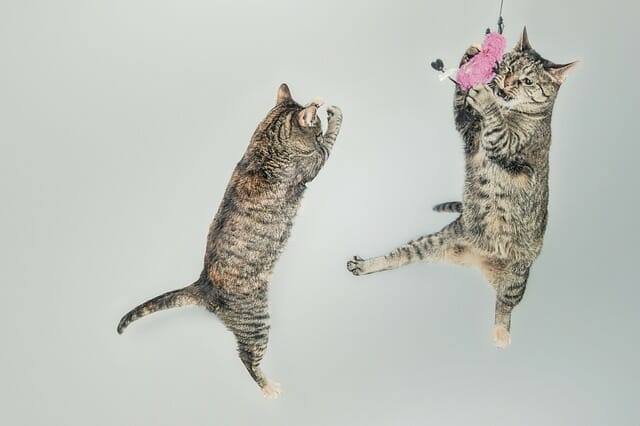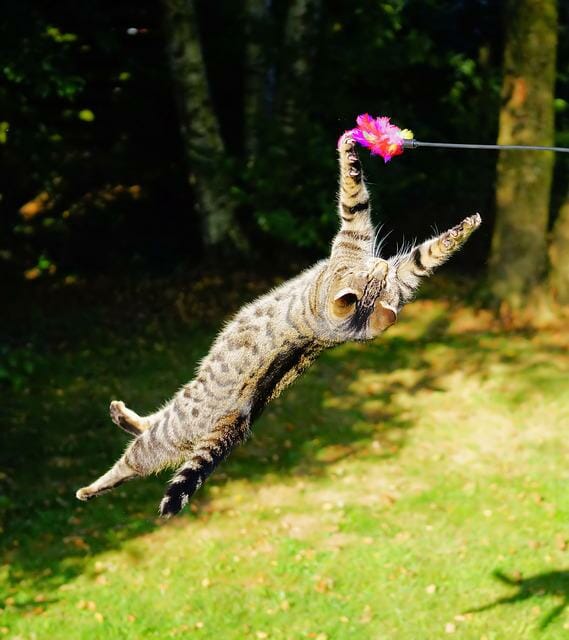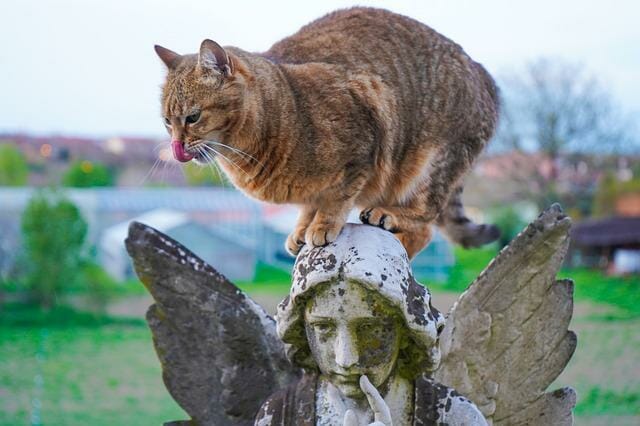How High Cat Can Jump: Understanding the Jumping Ability of Cats
On average, a healthy adult cat can jump five to six times their body length in a single bound and reach heights several times its height. However, a cat’s exact height depends on various factors such as age, breed, size, and physical condition. Some cats, such as the athletic Bengal breed, may be able to jump even higher than others.
Cats are natural-born hunters, and their ability to jump high is an important part of their predatory skills. Their unique skeletal structure and powerful muscles enable them to jump with great agility and precision. Several factors contribute to a cat’s ability to jump high, including its flexible spine, strong leg muscles, and light body weight.


Table of Contents
Why Cats Can Jump High
Flexible Spine
Cats have an incredibly flexible spine, which allows them to jump with remarkable agility and precision. The flexibility of their spine is due to several unique features of their skeletal structure.
Firstly, cats have many vertebrae in their spine, giving them increased flexibility and range of motion. For example, cats have 30 vertebrae, depending on their tail length. This number of vertebrae means the cat’s spine can bend and twist in various ways.
Secondly, highly flexible cartilage discs separate the vertebrae in a cat’s spine. This allows the spine to bend and twist more easily and reduces bone and joint stress.
Thirdly, the ligaments and muscles supporting the cat’s spine are highly elastic, increasing flexibility. As a result, these muscles and ligaments can stretch and contract rapidly, allowing the cat to move quickly and precisely.
All of these factors give cats an incredible amount of control over their spine and allow them to make quick adjustments and changes in direction while jumping. For example, when a cat jumps from a standing position, it will typically crouch down and then quickly extend its legs and arch its back to launch into the air. Once in the air, the cat can twist and turn its body to adjust its trajectory and land on its target.
Strong Leg Muscles
Cats have powerful muscles in their hind legs that generate a lot of force when jumping, enabling them to leap to great heights and distances. Several key muscles in a cat’s hind legs contribute to its jumping ability. These include the quadriceps, hamstrings, and gastrocnemius muscles.
The quadriceps muscle is located on the front of the thigh and extends to the knee joint. This muscle is particularly important for jumping as it helps to propel the cat’s body upward. The hamstrings on the back of the thigh work in opposition to the quadriceps to flex the knee joint. These muscles are important in helping the cat launch forward during a jump.
The gastrocnemius muscle in the calf is responsible for extending the ankle joint. This muscle is particularly important for landing after a jump, as it helps the cat to absorb the impact of landing.
In addition to these muscles, cats have the unique ability to store energy in their tendons. For example, when a cat crouches before a jump, it stores energy in its tendons, which can be released quickly to help propel the cat into the air.
Light Body Weight


A cat’s light body weight means it has less mass to propel into the air, making it easier for the cat to achieve greater heights. The average domestic cat weighs between four to five kilograms. This relatively small body size means cats require less energy to move their bodies, allowing them to jump more easily and quickly.
In addition to their small size, cats have a high muscle-to-fat ratio. This means they have a greater proportion of muscle mass relative to their body weight, giving them more power and speed when jumping.
Another advantage of having a light body weight is that cats can land more gracefully after a jump. When a cat lands, it experiences a certain amount of impact force, which can harm the body if not absorbed properly. However, because cats are relatively light, they can absorb this impact more easily, reducing the risk of injury.
Sharp Claws
Cats’ sharp claws are a key factor that allows them to jump high. The claws allow cats to grip onto surfaces and propel themselves upward and forward during a jump. Cats use their claws to grip surfaces like the ground or a tree trunk to gain traction and provide a stable base for their jumps. This helps them to generate more force and achieve greater heights.
When a cat prepares to jump, it often digs its claws into the ground to gain leverage and propel itself forward with greater force. Cats also use their claws to grip surfaces when landing, which helps to absorb the impact of the landing and prevent injury. The claws also allow the cat to adjust its landing position mid-air and land on its feet, which is why cats are known for their ability to always land on their feet.
Additionally, the retractable nature of a cat’s claws is important for its jumping ability. Cats can retract their claws when not in use, which helps to prevent them from getting caught on surfaces or hindering their movements. However, when needed, they can quickly extend their claws to grip surfaces and use them for propulsion or balance during a jump.
How to Keep Your Cat Safe When Jumping


Jumping is a natural and instinctual behavior for cats, but it can also pose some risks to their safety. For example, to ensure your cat’s safety when jumping, make sure that your cat has a soft, cushioned landing surface to jump onto, such as a carpet or a padded bed. This can help to absorb the impact of the landing and prevent injury.
Make sure that there are no sharp or dangerous objects in the area where your cat is jumping. Keep breakable objects or items that could harm your cat out of the way. Avoid encouraging your cat to jump from heights that are too high for their safety. Cats are natural climbers and jumpers, but too much of a high jump can lead to injuries.
Provide your cat with regular opportunities for exercise to keep them physically fit and agile. This can help to improve their jumping ability and reduce the risk of injury. Additionally, schedule regular check-ups with your veterinarian to ensure that your cat is in good health and that their bones and muscles are strong enough to jump.
